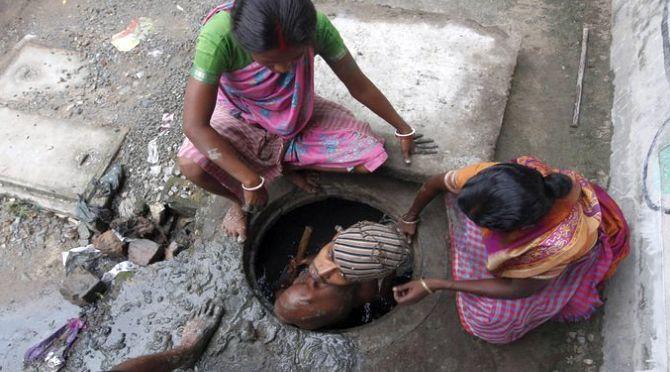Latest Govt Survey Counts Over 50,000 Manual Scavengers Across 12 States

There are 53,236 manual scavengers across 12 states in India, a four-fold rise from the 13,639 such workers accounted for in official records until 2017, according to the latest survey being conducted by the central government, The Indian Express reported.
The data, however, is compiled based on the information collected from only selected 121 districts of the 12 states – Andhra Pradesh, Assam, Gujarat, Haryana, Kerala, Madhya Pradesh, Maharashtra, Punjab, Rajasthan, Tamil Nadu, Uttar Pradesh and Uttarakhand, surveyed by the National Safai Karmacharis Finance and Development Corporation (NSKFDC). NSKFDC has been given the task of identifying the manual scavengers by conducting surveys in several phases, after the government announced last year to compensate and rehabilitate such workers as per the Prohibition of Employment as Manual Scavengers and their Rehabilitation Act, 2013. This phase of the survey is yet to be conducted in Bihar, Jammu and Kashmir, Jharkhand, Karnataka, Telangana and West Bengal.
While the ongoing survey was planned to cover 164 identified districts across 18 states, numerous media reports have pointed out flaws in the way the survey is being conducted. Furthermore, the survey includes only those manual scavengers who clean dry latrines and pit latrines, while those involved in the cleaning of sewers and septic tanks and scavengers in the railways (largest employer of manual scavengers) are not counted.
Moreover, much of urban India has not been included in the survey, the report stated. This is because the Ministry of Housing and Urban Affairs failed to maintain the data on number of sanitary and insanitary toilets in the urban areas.
Highest number of manual scavengers – 28,798 – has been registered in Uttar Pradesh, whereas states – Maharashtra , Madhya Pradesh, Rajasthan and Uttarakhand, which had earlier reported zero or about 100, have now upped their count, it has been reported.
Although the survey included NGOs Safai Karmachari Andolan and the Rashtriya Garima Abhiyan as third parties for assisting field work counting, as the main responsibility was handed over to the NSKFDC, inefficiency in conducting the survey was reported from various states. NSKFDC’s nodal officers, who are responsible for the implementation of self-Employment for Rehabilitation of Manual Scavengers (SRMS) scheme, have the record of maintaining the SRMS funds underutilised.
The crucial question here is that will the manual scavengers identified by the survey be compensated or not? The government had earlier claimed to provide them benefits such as cash assistance of Rs 40,000, two years of skill-development training with a stipend Rs 3000 per month, subsidised loan for self-employment projects, pre-matric scholarships and so on. On the other side, the central government has allotted only Rs 30 crore for Safai Karamcharis and Manual Scavengers in 2018-19. It is to be seen if the government would keep its promises or not.
In spite of a law prohibiting manual scavenging, in 2017 alone, over 300 cases of deaths due to manual scavenging were reported from across the country.
Ashif Shaikh, an anti-manual scavenging activist and founder of Jan Sahas in Madhya Pradesh pointed out that in the last 26 years, national governments have conducted seven national surveys with numerous modifications in the identification of manual scavengers. While a survey conducted in 1992 identified 5.88 lakh manual scavengers, the number went up to 6.76 lakh in 2002-2003, which had later reduced to mere 13,639 in a 2013 nationwide survey.
Get the latest reports & analysis with people's perspective on Protests, movements & deep analytical videos, discussions of the current affairs in your Telegram app. Subscribe to NewsClick's Telegram channel & get Real-Time updates on stories, as they get published on our website.
























